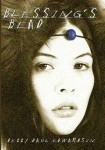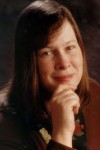 I’m very excited to have Debby here. We’ve “known” each other for years on a Yahoo group for kid’s writers and I remember when she sold Blessing’s Bead, her debut novel, out now. Here’s a bit about the book:
I’m very excited to have Debby here. We’ve “known” each other for years on a Yahoo group for kid’s writers and I remember when she sold Blessing’s Bead, her debut novel, out now. Here’s a bit about the book:
- Do you eat right, get plenty of exercise, and sleep eight hours a day, or do you sit in front of your computer writing all the time?
Truth? I spend a lot of time sitting in front of my computer, writing and surfing. In my timeline of history, the invention of the word processor rates as a significant event, right next to the development of the internet. Sure, I try to eat healthy foods, get exercise and lead a well-balanced life, but I admit it: my computer connects me to the world of my own writing and to the universe of children’s writing and these are important things for me. I live in one of the more remote places on the planet and the only connection I have to the world of writing is through books and through my computer. Think of it: I live in the northernmost community in Alaska. A plane ticket from here to Anchorage is over $700 —and Anchorage is not exactly the center of the writing universes—but here I sit, still in my pajamas, connecting with thousands of people, joining in on interesting discussions, teaching classes, reading and sharing critiques and following the journey of my latest book—all with just a few key stroke, so, sure, I spend a lot of time in front of my computer!
- Do you use an outline when writing, or just let it flow and write as fast as you can?
I’m one of those writers who tends to think of plot as a four-letter word, which is to say I don’t use an outline. I wish I could. I wish I could just sit down, write out a perfectly shaped outline and spill the book out into neatly apportioned sections, but I’m not that kind of writer. I think I’ve looked at every plotting book and outlining tool in existence, but in the end, they always leaving me feeling like Cinderella’s step sister—the one forever trying to cram her big foot that into that itty bitty glass slipper.
In the end, of course, I have to find a shoe that fits, just like everyone else. And it doesn’t actually hurt if it’s a bit tight, figuratively speaking. As every poet knows, the constraints of structure are transformative. But I have to write the thing, first. I have to let the work surprise me and take me to places I would never in my waking moments imagine. Then I take a look at structure—what fits or could fit or should fit with the story I am trying to tell.
So no, I don’t use and outline, but yes, I think a lot about story. There are a lot of different ways of looking at structure and a lot of different ways of articulating the rules, but they all lead to the same place. Some people talk about the story’s conflict; some prefer to call it struggle. Some talk in terms of narrative arc, some see it as more akin to what Ursula LeGuin referred to when she called a book, “a medicine bundle, holding things in a particular, powerful relation to one another and to us.”
I like that.
My own theory is that some people are forest people and some people are tree people. That is, some see the whole sweep of the story and like to jump in and sort it out, tree by tree. Others prefer to work outward, one tree at a time. Tree people generally have to make the map of after they’ve already begun the journey, but that’s okay. It’s all about finding what works for you as a writer and what works for that book you are writing because we are all of us different, and every book is, likewise, unique.
- What author or book have you recently discovered that you want the world to know about?
Well it goes more like this: what author did I discover a long time ago that the rest of the world finally knows about, no thanks to me? Easy, Sherman Alexie. Alexie’s book The Lone Ranger and Tonto Fistfight in Heaven is one of my all time favs and I have been singing its praises for years. So when Alexie won multiple awards for The Absolutely True Diary of a Part Time Indian I felt validated, somehow. As if I had anything to do with it!
- If you could live anywhere for a year, where would it be? And what kind of a place would you live in?
In an adobe house in the mountains of northern New Mexico—the Sangre de Cristos, because I just love that name for the red earth heart region of New Mexico. Or maybe I’d go to Abiquiu, the canyon land where Georgia O’Keffe drew her inspiration.
I love the desert.
I also love the ocean and the high arctic and so I might choose a tropical beach or the wild and uninhabited foothills of the Brooks Range, where you can see forever and feel, daily, as if you have just arrived at the beginning of the world. And then, again, I might go back to an island on a little lake in the boundary waters of Northern Minnesota where I spent summers, growing up, with my artist mom and my imagination.
- Do you speak any foreign languages?
I speak Norwegian and I understand a lot of Inupiaq.
- When’s the last time you rode a bike?
About a month ago. I LOVE bike riding. Sometimes when I travel I even rent a bike instead of a car. I did that in San Diego last spring—San Diego is a great place to ride bikes. When I was younger, I rode bikes exclusively. In fact, I didn’t even get a driver’s license until I was 28. But that’s another story. Bike riding in the Arctic, alas, is not a year round proposition for me. Biking at -60 is one skill I have yet to master!
- Go on, give us some writing advice. You know you want to!
To steal a slogan: Just do it. Read and write, read and write, read and write. In the end, the only thing that separates a real writer from a wanna be is that the real writer sits down in that chair and writes. Every day.
And be sure to find a mentor. Whether you find one through reading or find one in person, you need a mentor. Writing is a craft and you improve through practice and apprenticeship. Writing is also like an athletic practice. You have to keep the writing muscle toned.
Connect with your writing peers and start or join a critique group. Learning to look critically at the work of others and learning how to help others solve their own story problems will propel you along your own journey of learning to do the same with your own writing.



I am sure this is going to be a great book.
I have been asking myself am I a tree person or a forest person.
Hmm, I think it depends, sometimes when I think of a story I think of everything all at once and quickly jot down an outline so I can remember exactly how I want it to be. Other times I take it one sentence at a time and let it lead me to where it is intended to go. Am I a mixture or a writer mutt?
Great interview, Joelle — thanks! And congratulations again, debby. i am soooo excited for you but also for the rest of us getting a chance to read this book which sounds simply amazing. hope you’re coming to juneau sometime this year!
Sounds like a great book. I love intergenerational stories!
I remember seeing an early draft and can’t wait to see the published book. Congratulations, Debby!
Blessing’s Bead sounds wonderful! Congratulations to Debby for her success, and thank you, Joelle, for another great interview.
Ooh, this one sounds good!!
When Joelle announced that she had interviewed Debby, I couldn’t wait to read the post. You see, I was hanging around the ‘net with Debby all those years ago, too, and am so very pleased to see her success.
Congratulations, old friend!
Whale Snow still sits in a place of honor on my central book shelf, and I look forward to tucking Blessing’s Bead in beside it.